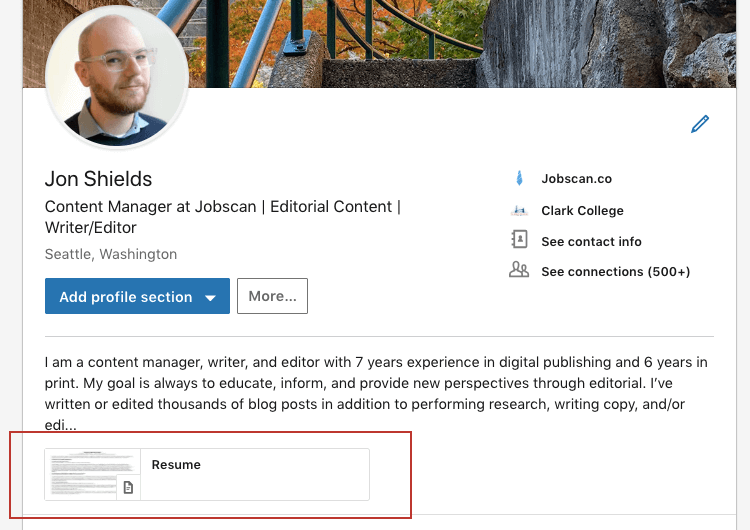In today’s job market, your online presence can be just as important as your resume. Including your LinkedIn profile in your resume is a savvy move that can showcase your professional persona. But how do you do it effectively? This post will guide you through the importance of linking your LinkedIn profile and give you tips on integrating it seamlessly into your resume.
Why Your LinkedIn Profile Matters

Let’s face it: recruiters are increasingly turning to LinkedIn to find potential candidates. Your LinkedIn profile serves as a digital extension of your resume, allowing you to present a fuller picture of who you are as a professional. Here’s why it matters:
- Comprehensive Overview: Unlike a traditional resume, your LinkedIn profile lets you elaborate on your experiences and skills. You can include details about projects, publications, and even volunteer work that might not fit on your resume.
- Endorsements and Recommendations: LinkedIn allows colleagues and supervisors to endorse your skills or write recommendations. This social proof can differentiate you from other candidates.
- Networking Opportunities: Your LinkedIn profile can help you connect with industry leaders, peers, and potential employers. A strong profile increases the chances of networking opportunities, which can lead to job offers.
- Search Visibility: Recruiters often search for candidates using LinkedIn. By having a well-optimized profile, you increase your chances of being found for relevant roles.
- Showcase Your Personal Brand: Your LinkedIn is a canvas to reflect your personal brand. You can use your profile to share articles, insights, and updates that highlight your professional interests and expertise.
In short, your LinkedIn profile is not just a digital resume; it’s a powerful tool for career advancement. By linking it in your resume, you provide recruiters with a way to delve deeper into your professional story. It’s an invitation for them to explore your qualifications beyond the bullet points.
In the next section, we’ll discuss how to effectively incorporate your LinkedIn profile link into your resume without it feeling out of place.
Also Read This: The Right Way to Message Hiring Managers on LinkedIn
3. When to Include Your LinkedIn Profile

Deciding when to include your LinkedIn profile on your resume can be a bit tricky. It’s not just about slapping it on there; it’s about making a strategic choice that enhances your application. Here are some key moments when you should definitely consider including your LinkedIn profile:
- You’re in a competitive field: If you’re applying for jobs in industries like tech, marketing, or finance, where networking plays a crucial role, a LinkedIn profile can showcase your connections and endorsements. This is especially important if your profile highlights relevant skills and recommendations from colleagues.
- Your profile is up-to-date: Ensure your LinkedIn is polished and reflects your latest accomplishments and experiences. If it’s been a while since you updated your profile, take the time to refresh it before including it on your resume.
- You want to highlight specific contributions: If your LinkedIn profile features articles, projects, or presentations that are relevant to the job you’re applying for, it’s a great time to include it. This can provide potential employers with a deeper insight into your expertise.
- Your resume is concise: If your resume is already tightly formatted and you find it challenging to include all your relevant experience, your LinkedIn profile can serve as a supplementary resource. It allows you to keep your resume concise while directing employers to more detailed information.
- The employer encourages it: Some job postings explicitly state that candidates should include their LinkedIn profiles. If that’s the case, definitely follow that advice, as it shows you’re aligned with their expectations.
Ultimately, including your LinkedIn profile can enhance your chances if it adds value. Just make sure it’s not outdated or unprofessional, as that could backfire!
Also Read This: Does LinkedIn Premium Really Help You Land a Job? Insights from Reddit
4. How to Link Your LinkedIn Profile on Your Resume
Now that you know when to include your LinkedIn profile, let’s talk about the best practices for linking it on your resume. After all, a well-placed link can make a significant difference:
- Use a custom URL: Instead of the default LinkedIn URL (which is often long and messy), customize your LinkedIn URL. Go to your profile settings and create a shortened version that includes your name or a professional reference. This makes your link look cleaner and more professional.
- Placement matters: Typically, you’ll want to include your LinkedIn link in the header of your resume, alongside your contact information. For example:
- Hyperlink for digital resumes: If you’re submitting your resume digitally (PDF or Word), consider hyperlinking the LinkedIn text. This allows employers to click straight through to your profile, making it easy for them to view your professional journey.
- Inform your audience: In your cover letter or your introductory email, mention that you’ve included your LinkedIn profile for more in-depth information about your experience. This sets the stage for employers to check it out.
- Ensure consistency: Make sure that the information on your LinkedIn profile aligns with your resume. Any discrepancies can raise red flags for potential employers.
Jane Doe
Email: [email protected]
Phone: (123) 456-7890
LinkedIn: linkedin.com/in/janedoe
Linking your LinkedIn profile effectively can provide a valuable connection to your professional presence online. With these tips, you’ll not only enhance your resume but also promote your personal brand!
Also Read This: How to Delete the Activity Section on LinkedIn and Clean Up Your Profile
5. Best Practices for Presenting Your LinkedIn Profile
Including your LinkedIn profile in your resume is a smart move, but how you present it can make all the difference. Here are some best practices to help you shine:
- Customize Your URL: Before adding your LinkedIn link, make sure you've customized it for a cleaner, more professional look. Instead of a URL filled with numbers and letters, opt for something like linkedin.com/in/yourname. This small change can create a more memorable impression.
- Use a Clear Label: Rather than just pasting the URL, use a simple label like My LinkedIn Profile. This indicates to potential employers what they can expect when they click on the link.
- Include It in the Right Section: Position your LinkedIn link strategically. Typically, you should place it in the contact information section at the top of your resume. This makes it easy for recruiters to find.
- Ensure Consistency: The information on your LinkedIn profile should match your resume. If you list a specific job title or accomplishment on your resume, it should be reflected in your LinkedIn profile as well. Consistency builds trust!
- Highlight Key Accomplishments: Your LinkedIn profile should not just be a copy of your resume. Use it as an opportunity to showcase key projects, skills, and endorsements that may not fit on your resume. This highlights your strengths and gives potential employers a deeper insight into your professional journey.
By following these best practices, you can ensure that your LinkedIn profile adds value to your resume rather than detracting from it. It's all about making a positive first impression!
6. Common Mistakes to Avoid
While adding your LinkedIn profile to your resume can be beneficial, several common pitfalls can undermine your efforts. Here’s what to watch out for:
- Neglecting Your Profile: One of the biggest mistakes is having an outdated or incomplete LinkedIn profile. Ensure your profile is fully filled out, with a professional photo, updated work experiences, and relevant skills. An incomplete profile can leave a negative impression.
- Using a Personal or Unprofessional Photo: Your LinkedIn photo should be professional. Avoid using casual pictures or selfies. Ideally, use a high-quality headshot where you’re dressed appropriately for your industry.
- Ignoring Privacy Settings: Double-check your privacy settings. If your profile is set to private, potential employers may not be able to see it when they click on the link. Ensure your profile is visible to the public for the best chance of making a good impression.
- Not Tailoring Your Profile: Just as you would tailor your resume for different jobs, your LinkedIn profile should reflect the specific roles you’re targeting. Highlight experiences and skills that are most relevant to the positions you’re applying for.
- Forgetting to Update Information: If you’ve made recent accomplishments or changes in your career, ensure these are reflected on your LinkedIn profile before including it in your resume. Keeping your information current is essential!
Avoiding these common mistakes will help you present a polished and professional online presence that complements your resume. Remember, your LinkedIn profile is often a first impression, so make it count!
 admin
admin








